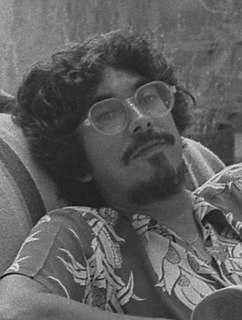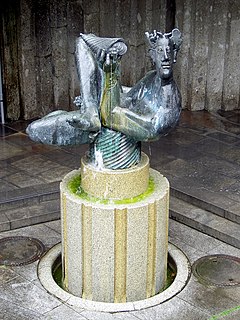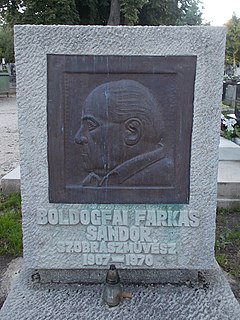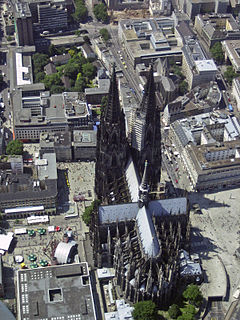
Bertel Thorvaldsen was a Danish and Icelandic sculptor medalist of international fame, who spent most of his life (1797–1838) in Italy. Thorvaldsen was born in Copenhagen into a working-class Danish/Icelandic family, and was accepted to the Royal Danish Academy of Art at the age of eleven. Working part-time with his father, who was a wood carver, Thorvaldsen won many honors and medals at the academy. He was awarded a stipend to travel to Rome and continue his education.

Mino da Fiesole, also known as Mino di Giovanni, was an Italian Renaissance sculptor from Poppi, Tuscany. He is noted for his portrait busts.

Arnolfo di Cambio was an Italian architect and sculptor. He designed Florence Cathedral and the sixth city wall around Florence (1284–1333), while his most important surviving work as a sculptor is the tomb of Cardinal de Braye in S. Domenico, Orvieto.

Gerhard Marcks was a German artist, known primarily as a sculptor, but who is also known for his drawings, woodcuts, lithographs and ceramics.

Robert Graham was a Mexican-born American sculptor based in the state of California in the United States. His monumental bronzes commemorate the human figure, and are featured in public places across America.

Walker Kirtland Hancock was an American sculptor and teacher. He created notable monumental sculptures, including the Pennsylvania Railroad World War II Memorial (1950–52) at 30th Street Station in Philadelphia, Pennsylvania, and the World War I Soldiers' Memorial (1936–38) in St. Louis, Missouri. He made major additions to the National Cathedral in Washington, DC, including Christ in Majesty (1972), the bas relief over the High Altar. Works by him are at the United States Military Academy, the Library of Congress, the United States Supreme Court Building, and the United States Capitol.

Baroque sculpture is the sculpture associated with the Baroque style of the period between the early 17th and mid 18th centuries. In Baroque sculpture, groups of figures assumed new importance, and there was a dynamic movement and energy of human forms—they spiralled around an empty central vortex, or reached outwards into the surrounding space. Baroque sculpture often had multiple ideal viewing angles, and reflected a general continuation of the Renaissance move away from the relief to sculpture created in the round, and designed to be placed in the middle of a large space—elaborate fountains such as Gian Lorenzo Bernini‘s Fontana dei Quattro Fiumi, or those in the Gardens of Versailles were a Baroque speciality. The Baroque style was perfectly suited to sculpture, with Bernini the dominating figure of the age in works such as The Ecstasy of St Theresa (1647–1652). Much Baroque sculpture added extra-sculptural elements, for example, concealed lighting, or water fountains, or fused sculpture and architecture to create a transformative experience for the viewer. Artists saw themselves as in the classical tradition, but admired Hellenistic and later Roman sculpture, rather than that of the more "Classical" periods as they are seen today.

The Zelter-Plakette is a German national award for choirs, founded in 1956 by President Theodor Heuss.

Ludwig Gies was a German sculptor, medallist and professor of art. He is best known for his crucifix in Lübeck Cathedral, vandalized in March 1922 and later considered a typical work of degenerate art, and his famous Federal Eagle (1953), which is hung at the front of the Plenary Hall of the Reichstag in Berlin.

Hans Karl Burgeff was a German sculptor, medal engraver and art lecturer, who worked mostly in the Rhineland.
Marian Brackenridge was an American sculptor known for her portrait busts, bas-reliefs and religious works.

Stefan Kaiser is a German sculptor.

Sándor Boldogfai Farkas was a Hungarian sculptor, medalist.
Elmar Hillebrand was a German sculptor.
Willy Weyres was a German architect and academic teacher. He was Kölner Dombaumeister from 1944 to 1972, diocesan master builder for the Archdiocese of Cologne for more than ten years, and full professor of architectural history and monument preservation at the RWTH Aachen from 1955 until his retirement in 1972. Under his leadership, the Cologne Cathedral was restored and further developed after the Second World War.

Karl Gustav Rutz was a German sculptor.

The Cologne Cathedral quarter is the area immediately surrounding Cologne Cathedral in Cologne, North Rhine-Westphalia, Germany. When the Gothic cathedral was built, it was closely surrounded by houses and smaller churches. When the cathedral was completed in 1880 as a national symbol, it was freed from adjacent structures and stood isolated, unhampered by traffic. After the inner city was destroyed in World War II, it was rebuilt, with a pedestrian area connecting to the cathedral. In 1970, the Domplatte was constructed as a large concrete surface without steps around the cathedral, which became the location of major open-air events such as Carnival and pop concerts. The design of the cathedral surroundings has remained a challenge for urban planning.
The Taubenbrunnen is a fountain sculpture designed by Ewald Mataré and erected in 1953 in the Altstadt-Nord district of Cologne, situated directly in front of the west side of the Cologne Cathedral.

Alexander McDonald, M'Donald or MacDonald (1794–1860) was a Scottish sculptor specialising in granite. He was also an expert on Egyptian granite sculpture.
















